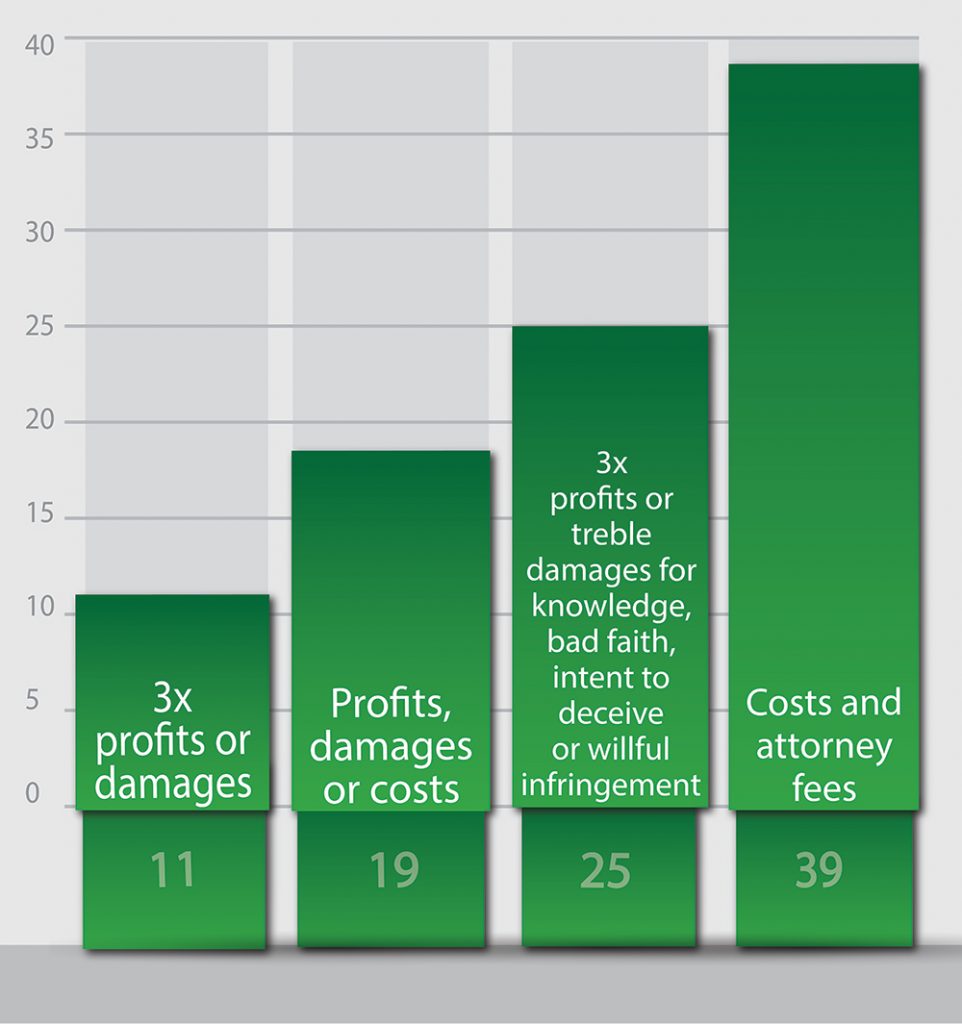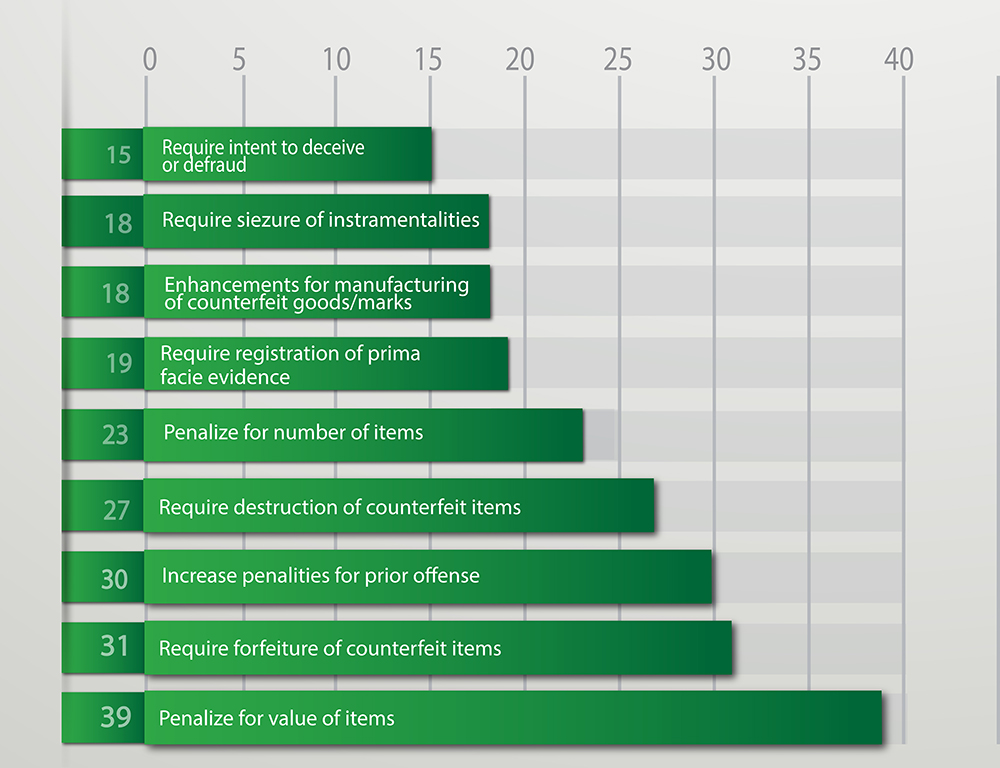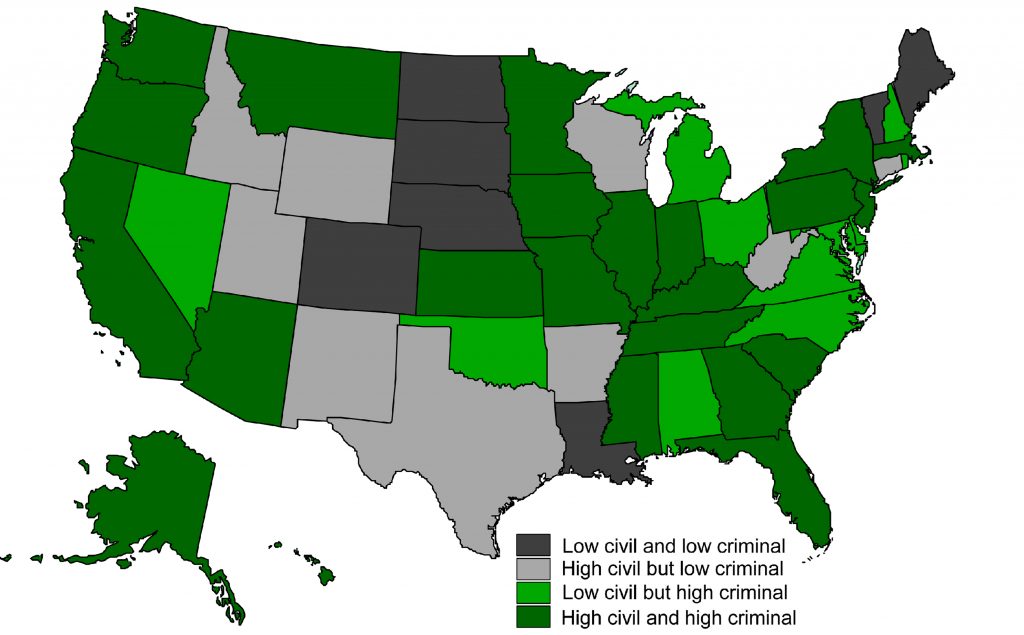Jeremy M. Wilson, PhD
Director, Center for Anti-Counterfeiting and Product Protection & Professor, School of Criminal Justice, Michigan State University
Brandon A. Sullivan, PhD
Assistant Professor, Center for Anti-Counterfeiting and Product Protection, Michigan State University
Travis Johnson, Esq.
Vice President for Legislative Affairs and Senior Counsel, International AntiCounterfeiting Coalition
Roy Fenoff, PhD
Assistant Professor, Department of Criminal Justice, The Citadel (The Military College of South Carolina)
Kari Kammel, Esq.
Assistant Director for Education and Outreach, Center for Anti-Counterfeiting and Product Protection, Michigan State University
Trademarks—words, phrases, names, symbols, designs, and logos used to identify the source of products or services and to distinguish them from other products and services—are protected by a variety of U.S. federal and state legislation. While U.S. federal trademark legislation is fairly well-known by brand protection professionals, the use of state legislation varies widely. Ongoing research by the Center for Anti-Counterfeiting and Product Protection analyzes state counterfeiting legislation to offer brand protection professionals a better understanding of how the legislation may help enforce their rights.
U.S. State Legislation
Although federal statutes are the primary means of protecting U.S. trademarks, each state also has laws protecting trademarks, both criminal and civil, with the exception of New Mexico having no criminal law. Because state and federal court have concurrent jurisdiction, state and federal charges on trademark infringement are permissible arising from the same facts.
Anti-counterfeiting laws are a narrower segment of trademark law; they vary by state and differ in many ways from federal statutes. Generally, state trademarks are only protected within the state of registration or by the state’s common law, while a federally registered trademark is protected throughout the United States. Nevertheless, businesses planning to operate only in one state may choose to register their trademark only at the state level, because the filing process is cheaper and tends to be quicker than federal registration.
Civil Remedies
Each state provides civil injunctions and monetary damages for a violation of the civil counterfeiting statutory provisions. In each state except Colorado, a trademark must be registered for an infringement lawsuit to be filed in state court. Every state but Colorado and North Carolina permit civil seizure of counterfeit articles, but only California requires the instrumentalities of counterfeiting to be seized as well.

All 50 states have statutes awarding damages to the plaintiff for trademark infringement. The maximum amount of monetary damages that may be awarded varies by state—hence, the likelihood that a brand owner will seek to litigate cases in a particular state may vary as well. Figure 1 highlights these different types of damages.
Criminal Sanctions
While the variation in state civil statutes regarding trademark infringement is largely limited to how damages are awarded, state criminal law varies more widely. While 41 states include product counterfeiting under a criminal trademark counterfeiting statute, several states have either an additional or alternative type of statute. These include: criminal simulation in 14 states, forgery in six states, and theft of trademarks in two states. Most states criminalize the counterfeiting of both registered and unregistered (common law) trademarks through their law, while 17 require proof of federal or state registration, and Vermont and Wisconsin require state registration. States also vary widely in characteristics of criminal law regarding product counterfeiting, as illustrated in Figure 2.

Seven states do not incorporate any of the above characteristics into their criminal law.
States similarly vary in criminal penalties and types of charges they levy for product counterfeiting, as illustrated in Figure 3.

Comparing Statues by State
To further analyze differences across states and compare the relative strength of civil and criminal anti-counterfeiting statutes, we created two indices: (1) civil remedies index, and (2) criminal sanctions index. Our civil remedies index accounts for protection by civil injunction, awarding damages, destruction of counterfeit articles, seizure of counterfeits, seizure of instrumentalities, inclusion of costs and legal fees in damages, minimum damages, and penalty enhancements, as well as restrictions of state trademark registration, maximum damages, and requirement of intent to deceive or defraud for award of damages. Our criminal sanctions index accounts for protection by forfeiture or destruction of counterfeit goods, penalties for number or value of items, increased penalties for prior offense, enhancements for manufacturing counterfeits, availability of misdemeanor or felony charges, incarceration and restitution penalties, and minimum fine and sentence, as well as restrictions of trademark registration for prima facie evidence, intent to deceive or defraud, and maximum fine of less than $20,000 and maximum sentence of less than five years’ incarceration.
We coded each element in the index as ‘0’ or ‘1’ and divided the sum of these scores for a civil remedies index score and a criminal sanctions index score. Each resulting index score ranged from 0 to 1. We used a score of 0.5 to divide states with low levels of sanctions from those with high levels. We then classified states as having low levels of both civil and criminal sanctions against counterfeiting (seven states), high levels of civil sanctions but low levels of criminal sanctions (nine states), low levels of civil sanctions but high levels of criminal sanctions (11 states), and high levels of both civil and criminal sanctions against counterfeiting (23 states). Figure 4 shows these results by state.

States with low levels of civil remedies and criminal sanctions may not be providing sufficient civil or criminal protections against counterfeiting. Those with high civil remedies, but low criminal sanctions, may need to update their laws to address product counterfeiting as a crime. Those with low civil but high criminal sanctions may have enacted the means to address product counterfeiting through legal action, but still offer limited redress for victims.
Conclusion and Future Results
Federal and state legislation offers many protections to brand owners, though both could be improved, particularly state legislation. The lack of uniformity in state criminal sanctions against product counterfeiting may prevent state legislation from being as strong as it could be against perpetrators of this crime.
Several areas of additional study may offer further insights on how legislation can be used to address product counterfeiting. One potential research topic is differences in enforcement of these statutes. Another is examining changes in criminal statutes and enforcement patterns. Finally, examining how state statutes change over time and what has influenced these changes, as well as how state legislation protecting trademarks differs by legislative composition, political environment, economic activity, industry lobbying, and federal legislative changes, would also provide a more complete picture of the impact of enforcement efforts.
For further information on product counterfeiting legislation, see the forthcoming A-CAPP Center research article by these authors to be published in the Summer 2017 issue of the Journal of Criminal Law and Criminology, Vol. 106, No. 3, pp. 521-564.
THE BRAND PROTECTION PROFESSIONAL | MARCH 2017 | VOLUME 2 NUMBER 1
2017 COPYRIGHT MICHIGAN STATE UNIVERSITY BOARD OF TRUSTEES
